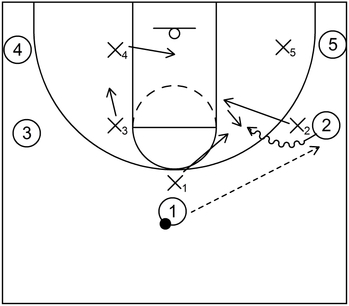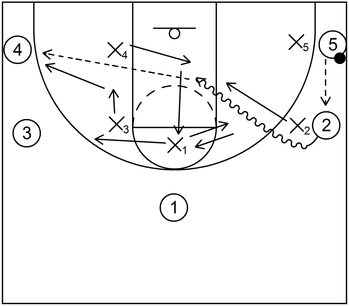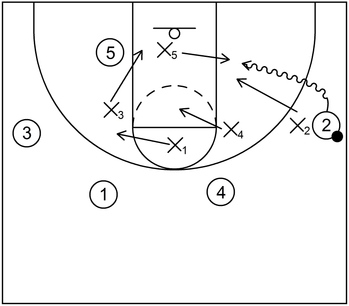What is help defense in basketball
Help defense, also known as help side defense, is a basketball defensive tactic that consists of one or more off-ball defenders providing support for an on-ball defender, ultimately to limit or prevent potential scoring opportunities of the offensive team.
What does help defense usually consist of
Help defense usually consists of adjacent off-ball defenders that are one pass away from the ball as well as additional off-ball defenders that are two or more passes away from the ball.
Defenders that are one pass away
If an off-ball defender is one pass away, this means that the offensive team only has to execute one pass before the ball reaches that same off-ball defender’s assignment.
For example, if an off-ball defender is near the right side wing but the ball is at the top, then that same off-ball defender is one pass away from the ball.
In other words, the offensive team only has to pass the ball one time, from the top to the right side wing, before it is in close proximity to that same off-ball defender.
Additionally, when the ball gets passed to the left side or right side of the court, off-ball defenders that are one pass away from the ball on that same side of the court could be considered strong side defenders.
Defenders that are two or more passes away
If an off-ball defender is two or more passes away, this means that the offensive team has to execute two or more passes before the ball reaches that same off-ball defender’s assignment.
As an example, if an off-ball defender is near the right side wing but the ball is on the left side wing, then that same off-ball defender is two passes away from the ball.
In other words, the offensive team has to pass the ball two times, from the left side wing to the top and then from the top to the right side wing, before it is in close proximity to that same off-ball defender.
What is the general help defense technique when the ball is one pass away
Jump to the ball
When the ball is one pass away, the help defender will initially jump to the ball as a way of limiting or preventing certain scoring options by the adjacent offensive players.
For example, if the ball is initially at the top but then, gets passed to the right side wing, this means that the defender initially guarding the player at the top is now a help defender.
Furthermore, the ball is one pass away from that help defender so that means that same defender should immediately jump to the ball on the air time of the pass to the right side wing.
By doing this, the help defender accomplishes at least two things.
No face cut
First, upon jumping to the ball, the help defender takes away the potential face cut by the player at the top.
In other words, if the player at the top decides to cut straight to the basket, that same player will have to cut behind the help defender as opposed to in front.
When that occurs, the player with the ball on the wing will have to throw the ball over the outstretched arms of the help defender if the cutting player was to receive it.
However, throwing this type of pass increases the chances of a potential turnover which is detrimental to the offensive team but beneficial for the defensive team.
No adjacent gap space
Second, after jumping to the ball, the help defender immediately plugs the gap space that is between the player on the right side wing and the player at the top.
What this essentially means is that the wing player with the ball cannot get good dribble penetration in that same gap space because the help defender is standing in that area.
In other words, if the player with the ball wants to drive to the basket, that same player can only go one direction, at least temporarily.
What are the general help defense techniques when the ball is at least two passes away
Slide toward post areas
When the ball is at least two passes away, the help defenders, near the top, the weak side wing opposite the ball, and/or the weak side corner opposite the ball should slide laterally towards the nail area, the weak side high post, and/or the weak side low post area respectively.
For example, let’s say the offensive team implements a 5 out formation which means there are five offensive players near the top, the left side and right side wings, as well as the left side and right side corners.
If that occurs and the ball gets passed to the right side wing, then the off-ball help defender guarding the left side wing, which would also be the weak side wing, is two passes away from the ball.
Moreover, the off-ball help defender guarding the left side corner, which would also be the weak side corner, is three passes away from the ball.
Therefore, those same help defenders should execute a lateral slide towards the left side high post elbow and the left side low post area respectively.
Furthermore, if the ball gets passed to the right side corner, then the off-ball help defender guarding the top is two passes away.
Additionally, the off-ball help defender guarding the left side wing is at least three passes away while the off-ball help defender guarding the left side corner is four passes away.
So, the help defender guarding the top should slide towards the nail area, which is at the center of the free throw line or high post area.
At the same time, the help defenders near the weak side wing and corner should slide laterally towards the left side high post elbow and left side low post area.
Slide into the lane
In certain instances, when the ball gets passed to a side of the floor, an offensive player may not occupy the low post area on that same side, such as the 5 out formation mentioned earlier.
When that occurs, an off-ball help defender, preferably one that is lower on the court, such as a weak side corner defender, can slide into the lane, also known as the paint, to protect the basket.
Furthermore, if an off-ball help defender slides into the lane to protect the basket, then an additional help defender on that same side of the court could drop back to stand in the gap between the weak side mid-post and the weak side corner.
The main purpose of standing in the weak side gap is to provide additional help defense if necessary, which is known as help the helper.
To demonstrate with the 5 out formation again, let’s say the ball gets passed to the right side wing. However, there is not an offensive player filling the low post area on that same side.
When that occurs, the help defender initially guarding the weak side corner could slide into the paint.
At the same time, the help defender initially guarding the weak side wing could drop back towards the weak side mid-post area and stand in the gap between the weak side wing and weak side corner.
What is the help the helper defensive concept
Help the helper occurs when one defender provides help, especially during dribble penetration, and then that same helping defender receives additional assistance from another help defender.
In other words, to help the helper means to give yet another layer of defensive support to work alongside the initial layer of help defense.
For example, let’s say the offensive team uses the 5 out formation once again. Afterwards, the ball gets passed to the right side wing and the offensive wing player creates dribble penetration towards the basket via a dribble move against the on-ball wing defender.
Let’s also assume the help defender near the top did not jump to the ball as well. When that occurs, a weak side help defender initially guarding the corner could slide into the lane to protect the basket and/or take a possible charge.
However, if the offensive player with the ball throws a kick pass or drift pass to the offensive player in the left side corner, the help defender that stepped into the lane most likely will not be able to recover in time.
So, this is where the defensive concept of help the helper comes into play. Essentially, the weak side help defender that was initially guarding the left side wing dropped back to the mid-post area.
By doing that, this gives that same help defender enough time to execute a defensive closeout against the offensive player in the corner.
At the same time, the defender that was initially covering the top area could provide help by switching over to the weak side wing while the help defender that was initially guarding the weak side corner could rotate to the top.
This is an example of help the helper. In a basic sense, each help defender can support the others and act as one unit by executing certain types of defensive rotations against the offensive players that are left temporarily open, specifically as a result of initial dribble penetration.
Why is help defense a useful tactic
Help defense is a useful and beneficial defensive tactic because it can mitigate the effectiveness of offensive dribble penetration and/or it can hinder basket cuts, especially by offensive players that are at least two passes away from the ball.
Mitigate the effectiveness of dribble penetration
As an example, let’s say an offensive player is in possession of the ball near the right side wing area and that same player is currently being guarded by an on-ball defender.
Afterwards, let’s also say that the offensive player with the ball is able to beat the on-ball defender with a dribble move of some sort and then create dribble penetration towards the middle of the lane.
From that point, if there are not any help side defenders, particularly near the right side high post area and/or left side low post area, then that offensive player with the ball could possibly dribble all the way to the basket and score with a layup or dunk.
On the other hand, if there is a help defender near the right side high post, then that same help defender could possibly hinder the dribble penetration, particularly after jumping to the ball.
Furthermore, even if the high post help defender does not jump to the ball to limit the initial dribble penetration, another help defender on the lower weak side, could slide into the lane to either protect the basket and/or take a charge.
Therefore, the offensive player with the ball would most likely be influenced to settle for a contested field goal attempt or possibly pass the ball to another teammate, preferably near the perimeter.
Hinder basket cuts
As another example, let’s say again that an offensive player is in possession of the ball near the right side wing and that same player is currently being guarded by an on-ball defender.
Let’s also say that a help defender, particularly near the left side corner, is not implementing proper help defense but is instead, executing unnecessary defensive pressure against the offensive corner player that is more than two passes away.
At this point, the offensive player in the left side corner could cut to the basket, receive the ball from the wing player, and score at the basket.
So, to prevent the potential cutting action, the help defender near the left side corner could get closer to the basket by sliding towards the low post area or sliding into the lane.
Afterwards, if the offensive player in the left side corner attempts to cut to the basket, that same player would have to deal with the help defender near the basket.
What are examples of help defense rotations
Example 1

This is an example of help defense when the ball is initially at the top. To begin, 2 receives the ball from 1 which triggers X1 to jump to the ball.
Therefore, if 2 attempts to create dribble penetration, particularly towards the middle, X1 is there to hinder that penetration.
Also, the help defense of X1 gives X2 enough time to get back in front to further prevent dribble penetration.
Furthermore, because the low post on the side of the ball is empty, X4 could slide into the lane while X3 drops back to the mid-post gap between the weak side wing and weak side corner.
Example 2

This is an example of help defense rotations when the ball is initially in the corner. Also, X1 begins near the nail area at the high post because the ball is two passes away.
To start 2 receives the ball from 5 and then, 2 creates dribble penetration towards the middle of the lane.
X1 attempts to mitigate the dribble penetration by stunting at the ball but it is ineffective.
Next, X4 steps into the lane to provide help defense from the weak side. As a result, 4 receives the ball via a kick pass from 2.
When that happens, X4 will probably not have enough time to recover to the weak side corner. Therefore, X3 helps the helper (i.e. X4) by executing a defensive closeout on 4.
Furthermore, X1 also helps the helper (i.e. X3) by standing in the gap between 1 and 3. Moreover, X4 fills the empty space near the center of the nail that was recently vacated by X1 while X2 recovers.
From this point, if 3 receives the ball from 4, then X1 is ready to execute a closeout. Also, if 1 receives the ball from either 4 (via a skip pass) or from 3, then X4 is ready to closeout as well.
Example 3

This is an example of help defense rotations when baseline penetration occurs from the wing with an empty strong side low post, empty strong side corner, and an offensive low post player on the weak side as well.
To begin, 2 executes a dribble move against X2 to produce dribble penetration towards the baseline. When that occurs, X5 gives help defense by stepping across the paint and just outside of the lane line near the right side low post area.
At the same time, X3 helps the helper by sinking down to the basket with the main purpose of cutting in front of the offensive low post player.
Furthermore, X4 near the strong side elbow, slides into the paint slightly below the free throw line while X1 stands in the gap between 1 and 3.
This variation of help defense is also known as a sink and fill because X3 sinks down to take away the easy drop pass to 5 near the basket while X4 fills the lane to hinder basket cuts or to execute a defensive closeout towards the perimeter if necessary.
Related: Sink and Fill – The Basketball Dictionary